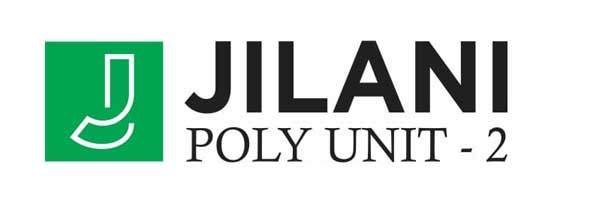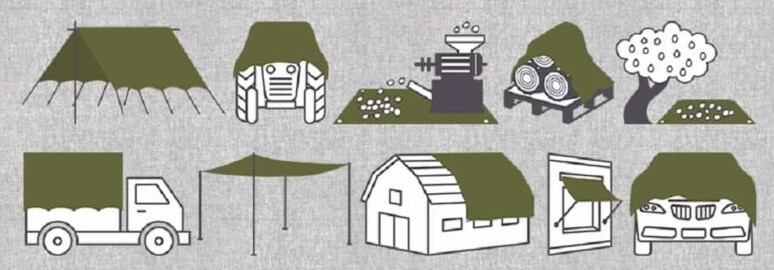Jilani Poly Unit 2 is a vertically integrated manufacturing facility [i.e. Spinning to Finish Product] with in house power generation of 12 MW. With state-of-the-art infrastructure we have a current monthly capacity of around 550 Tons PE tarpaulin.
All products at each manufacturing stage are tested [QA & QC] through in-house Physical testing lab [25 versatile testing equipment available] & Quality team
Each manufacturing process is run under qualified Polymer engineers for adapt functionality & consistency

We have a wide range of products catering to a broad spectrum of industries. They include:
PE Rolls
Introduction:
Tarpaulin, or tarp, is a heavy-duty, waterproof fabric, originally made of tarred cotton canvas and used by sailors. Today, tarps are commonly made of plastics such as polyethylene. Tarpaulin is a highly versatile fabric.
In addition to selecting a suitable color and size, note whether the tarp is graded light-duty, medium-duty, or heavy-duty. Technical specifications of the tarp may include:
Thickness, denier, and weave count are not so important when considered independently. The most important metric is weight since the combination of thickness, denier, and weave count will yield a certain weight. The heavier the tarp, the more heavy-duty it is.
Weight is a good metric of durability when choosing between different tarps of the same brand, but be careful when choosing between Brand A and Brand B. Don’t just look at weight and choose the cheapest brand. Some manufacturers use a high percentage of fillers and recycled PE to cut costs, and this will yield a poor-quality tarp even though it may be heavy. This is why it’s important to go with a trusted manufacturer.
Note also whether the tarp is UV resistant (UV stabilized), as most poly tarps are. If the tarp is not UV resistant, it may degrade within a few months of continued exposure to sunlight. If the tarp will be used at a construction site or close to a flame, you should also buy a flame retardant (FR) tarp. However, FR tarps are not fire proof. They will melt if continuously exposed to flame, but will not fuel the fire and facilitate combustion. FR tarps would stop burning after the source of the flame has been removed, whereas non-FR tarps could continue to burn after the flame has been removed.

Process of making Tarpaulin is integrated process which includes 4 stage process from extrusion to welding off to packing and finally storing in designated segregated storage area.
And from storage area it is shipped to customers through in line goods to transportation implemented dispatch system. Quality is maintained throughout the whole process through integrated quality management system.
First process in making PE Tarpaulin is melting HDPE granules to extrude through the specific dyes and making a sheet. Sheet is then slitted in the tape form, tape is then pass through heated plate for stretching and heat setting the polymer chains to make yarn strength and durability. Finally, this yarn is wound on bobbins to move to the next section. Yarn quality is controlled through the denier of the yarn.
Bobbins are transferred to the weaving department for further processing. Quick water jets looms are used for the waving of yarn into weaved materials in form of sheet, we can use different weave in warp and weft according to strength required or as required by the customers to ensure the quality of the weaved material.
Next and most important process after weaving is to coat the material for water proofing and other desired properties required such gsm, color, fire resistance and UV resistance of the end product. Printing of the logo or LDPE printed sheet is also done at the same point during the coating process. Coating is done on the both side of the sheet. Side waste is cut off o during process to ensure to smooth and even texture. This process is called the heart of tarpaulin making. It is also critically monitor like every previous stage by quality department as specified by the Quality Plan.
Next in line Is the welding process which is done by state-of-the-art welding machine, here we set the width and length of the tarpaulin according to the customer requirements. Furthermore, hemming is done with reinforced rope on the side of the tarpaulin to ensure maximum strength and withstand power. Length wise aluminum eyelets are placed on welding machine, further process is done in the next process after quality ensured the product is ok according to the specification and no critical fault is found.
Lengthwise hemming is done on the welding machine but for reinforcing the width we have to hem this side on manual hamming machine with reinforced rope inside it same as previous practice. Tarpaulin is again checked and determined for any defects by quality department, to move the tarpaulin in next stage.
After hamming is done on the width side of the tarpaulin now it’s time to put the eyalet on the manual hemmed side of the tarpaulin. This process is also done manually while operator also checks for any other missing eyelets on any side of the tarpaulin. Then it is moved for further visual inspection and specification check by quality department. If everything found according the product specification and no fault is found then it will be folded for the final stage of the process.
After folding process is done now next step is pressing and bale making. during this stage is sticker or product information is pasted on every tarpaulin and ever bale which is made is this entire process. After bale Is made quality department will ensure the quality of bale, sticker, weight and dimensions, these are critical factors. Dimension plays an important role during the loading of the product.
After the bale is made and cleared by the quality department. Its finally time to move the bales to designated storage area and placed according to the segregation or classification of the tarpaulin.
+92-42-111-200-600